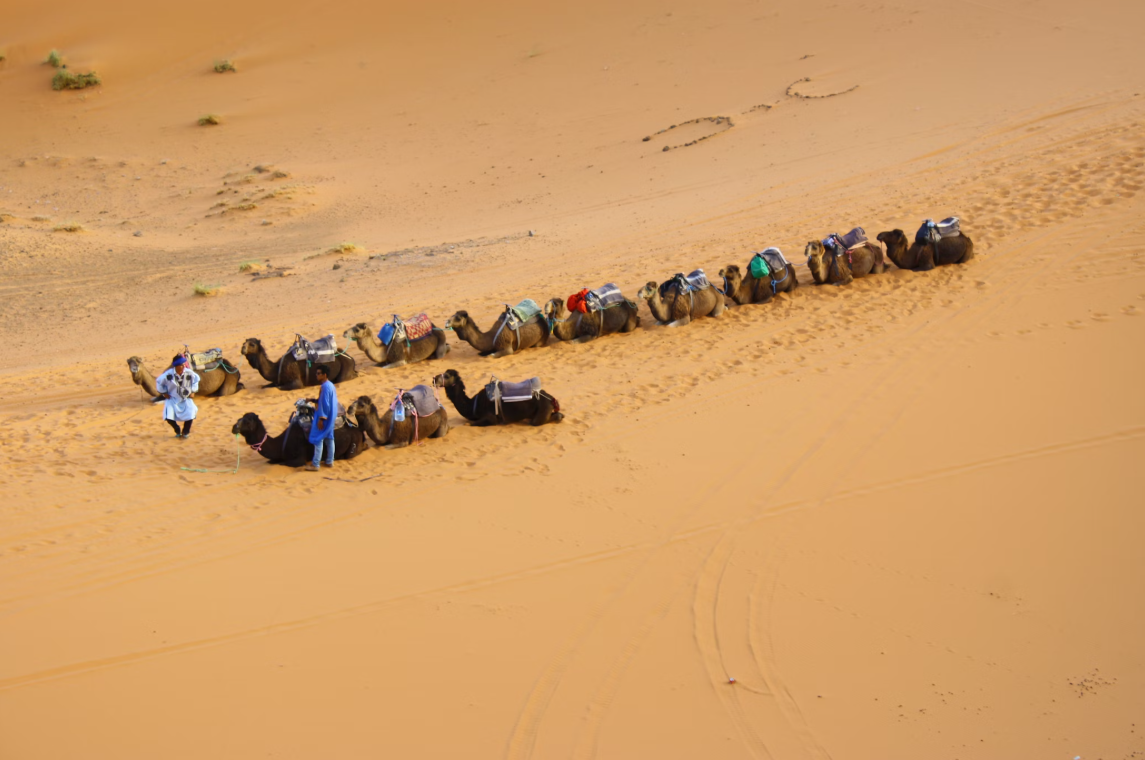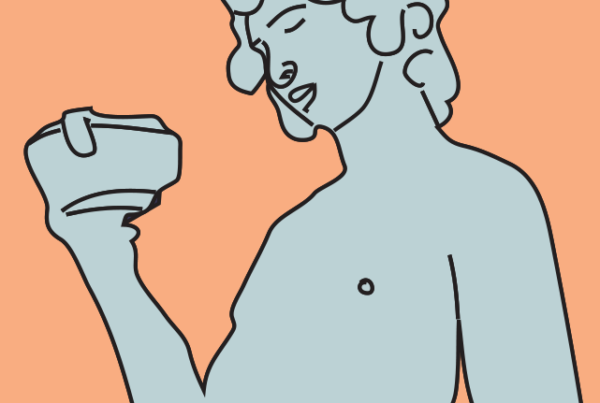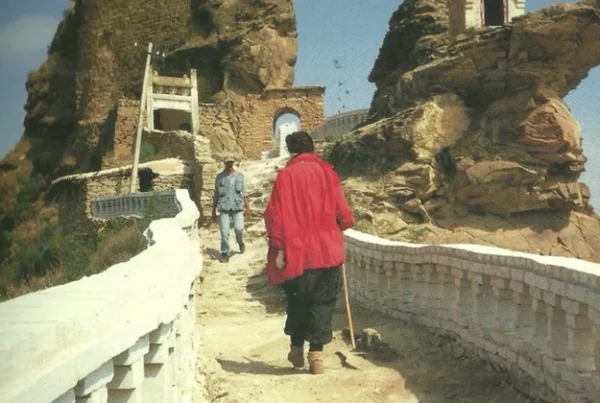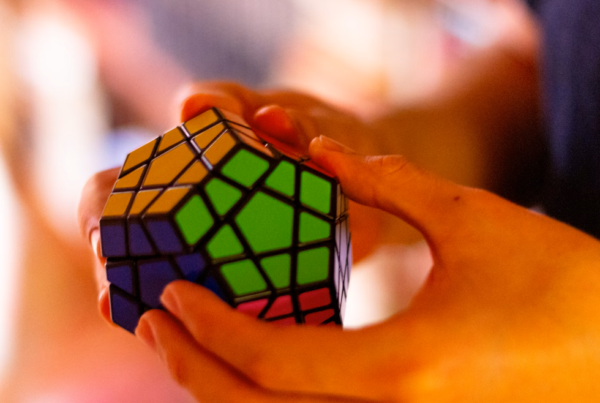
When you think of the word navigation, what comes to mind? Is it the GPS on your phone that directs you to a new restaurant? A too-large-to-carry physical map from your last vacation? The way to campus you remember from months of taking the same route? Or your ability to wake up at midnight and find your way to the bathroom, half-asleep, without having to turn on the lights?
When you think of the word navigation, what comes to mind? Is it the GPS on your phone that directs you to a new restaurant? A too-large-to-carry physical map from your last vacation? The way to campus you remember from months of taking the same route? Or your ability to wake up at midnight and find your way to the bathroom, half-asleep, without having to turn on the lights?

Photo by Savvas Kalimeris

Photo by Savvas Kalimeris
Getting from one place to another, be it several miles or only a few steps, is so common and mundane a thing that you rarely stop to think how you do it. It’s just something your body knows, and in the times that it doesn’t, you have Google Maps to help. In both cases, you need a sense of the relative distance between you and your destination based on which you decide how you travel and where you turn. But how exactly do you do this?
Long before the era of the global positioning system (GPS), humans relied on their natural sense of navigation and spatial ability. Anthropological perspectives highlight that the success of the Homo Sapiens as a species can be partly attributed to their ability to navigate and meet other social groups (Burke, 2012). When one group of prehistoric humans encountered another group, they shared valuable information about the location of resources and movements of predators, and exchanged parts of their material culture (e.g., tools, pottery, clothes). Maintaining such social networks across time and space would have necessitated excellent navigation skills, spatial awareness, and a capacity to store countless mental maps of the Paleolithic landscape. Navigation in human evolutionary history, therefore, was critical to sustenance and survival. There is reason to think this is true even today, leading some researchers to suggest that the ability to navigate may be a part of our genetic makeup (Xu et al., 2021; Lee et al., 2013).
Modern-day hunter-gatherer societies, like the Aché in eastern Paraguay, the !Kung in the Kalahari Desert in southern Africa, and the Hiwi in Venezuela are expert wayfinders much like their ancestors. For them, walking sixty miles through day and night to visit a neighbouring village is no big deal (Scott, 2016). Modern-day Inuit use features of the snow like drift patterns created by winds and ocean currents to develop what is called a “memoryscape” – a mental map of the landscape that outlines not only its physical features, but its cultural features too, where every lake, trail track, and forest holds social and historical meaning (Aporta, 2009). This memoryscape of routes and directions is passed down orally across generations, much like a cultural artifact.
“This memoryscape of routes and directions is passed down orally across generations, much like a cultural artifact.”
While anthropologists look at social groups to understand human navigation, neuroscientists look at brains. When we decide how to get from one place to another, our brain compares the distance between our current position and our destination, and decides on a path to get there. This path is called a route. Say, for instance, the route to your university campus. Imagine yourself biking from your home to campus – you know you have to bike straight for a few minutes and take a turn left, bike some more, and then take a right. What if, one day, you see the end of your street blocked by construction work? Would you be able to get to campus by following the same route as you do every day? No, you would probably need a map of the area to get to campus under these new conditions, following a different route. The brain needs to know not just how to get from your current position to your destination, but also mental representations of the relevant locations and the relationships between them. This “cognitive map” (Tolman, 1948; O’Keefe & Nadel; 1978) helps the brain navigate the external spatial environment.
Current research shows that spatial navigation involves several brain regions for processing spatial information, primarily within the hippocampus. Functional magnetic resonance imaging (fMRI) studies indicate that the hippocampus and entorhinal cortex – subdivisions of the medial temporal lobe – support map-like spatial codes, meaning that these regions create and maintain internal representations of space similar to a cognitive map (Epstein et al., 2017; Jacobs et al., 2013; Ekstrom et al., 2003). More specifically, the hippocampus contains place cells, which activate when an individual is in a specific location, while grid cells in the entorhinal cortex are activated when an individual moves through space. Another interesting feature of the hippocampus in relation to navigation is its ability to store multiple maps that allow it to represent multiple environments, or multiple states of the same environment (Steemers et al., 2016). This ability to distinguish between contexts is key to navigating different spaces that may share overlapping features.
To actually make use of a cognitive map, there needs to be a way to connect the map’s coordinates with aspects of the physical environment, like buildings, statues, or street signs. These objects are commonly termed “landmarks”, and serve as reference points that anchor their respective mental representations. Three cortical regions are implicated in processing information about landmarks (Nasr et al., 2011; Epstein, 2008): the parahippocampal place area (PPA), the retrosplenial complex (RSC), and the occipital place area (OPA). For example, looking for your car in the parking lot of a shopping complex becomes so much easier if you remember you had parked near, say, “Block D”. This landmark anchors your cognitive map of the parking lot to the actual physical space.

Anatomical locations of PPA, RSC and OPA, three brain regions involved in navigation (Xia et al., 2013)
“By consciously engaging with our surroundings – choosing to navigate without a map when possible, paying attention to landmarks, and embracing safe exploration – we exercise the neural circuits that have guided humans for millennia”
But humans navigate far more than just physical spaces. They also navigate interpersonal relationships and abstract concepts. Researchers wonder then, if brain mechanisms like spatial coding and landmark anchoring can apply to nonphysical “spaces”. Recent evidence suggests that the hippocampus can store nonphysical codes which can be used to navigate, for example, hierarchies and affiliations between characters in a social role-playing game (Tavares et al., 2015), or parallel storylines within a movie (Milivojevic et al., 2016).
There is little doubt that over the years, we have lost some of the incredible wayfinding abilities of our ancestors. Why could this be? One reason, of course, is that society has evolved and humans, in an urban cityscape, no longer have to travel long, perilous routes to forage for food, shelter, or connection. And for the spaces we do have to navigate, tapping our destination into Google Maps and following directions is all we need. As easy as this has made life, recent studies show that greater GPS use habits correlate to decreased performance on spatial awareness tasks and lower topological understanding (Dahmani & Bohbot, 2020). Some suggest that an overreliance on the destination-oriented GPS turns humans into “passengers in their own body”, as opposed to direct wayfinding which involves a deeper engagement with the physical environment (Ingold, 2011).
A mental sense of space – a cognitive map – is still important, and something a GPS might never be able to give us. People with spirits of wanderlust may agree that a proficiency at navigating allows you the freedom to explore new places, and travel without fear of the unknown, because it is likely you will find your way back. Interestingly, the hippocampus, in addition to being our brain’s navigational motherboard, also plays a role in the formation of autobiographical memories (Audrain et al., 2022): patients with hippocampal damage have trouble remembering what has happened to them (Addis et al., 2007). It may not be a stretch, therefore, to suggest that the hippocampus may be responsible for helping us navigate our inner worlds alongside our outer ones.
Yet, as modern technology makes navigation effortless, we risk disengaging from the very cognitive skills that once defined us. The good news? We can reclaim these abilities. By consciously engaging with our surroundings – choosing to navigate without a map when possible, paying attention to landmarks, and embracing safe exploration – we exercise the neural circuits that have guided humans for millennia. So, the next time you step outside, take a moment to look around, pay attention to your surroundings, and trust your brain to lead the way. Your ancestors did it – so can you. <<
References
- Addis, D. R., Moscovitch, M., & McAndrews, M. P. (2007). Consequences of hippocampal damage across the autobiographical memory network in left temporal lobe epilepsy. Brain: a journal of neurology, 130(Pt 9), 2327–2342. https://doi.org/10.1093/brain/awm166
- Aporta, C. (2009). The Trail as Home: Inuit and Their Pan-Arctic Network of Routes. Human Ecology, 37, 131–146. https://doi.org/10.1007/s10745-009-9213-x
- Audrain, S., Gilmore, A. W., Wilson, J. M., Schacter, D. L., & Martin, A. (2022). A Role for the Anterior Hippocampus in Autobiographical Memory Construction Regardless of Temporal Distance. The Journal of neuroscience: the official journal of the Society for Neuroscience, 42(33), 6445–6452. https://doi.org/10.1523/JNEUROSCI.0832-22.2022
- Burke, A. (2012). Spatial abilities, cognition and the pattern of Neanderthal and modern human dispersals. Quaternary International, 247, 230-235.
- Dahmani, L., & Bohbot, V. D. (2020). Habitual use of GPS negatively impacts spatial memory during self-guided navigation. Scientific reports, 10(1), 6310. https://doi.org/10.1038/s41598-020-62877-0
- Ekstrom, A. D., Kahana, M. J., Caplan, J. B., Fields, T. A., Isham, E. A., Newman, E. L., & Fried, I. (2003). Cellular networks underlying human spatial navigation. Nature, 425(6954), 184–188. https://doi.org/10.1038/nature01964
- Epstein R. A. (2008). Parahippocampal and retrosplenial contributions to human spatial navigation. Trends in cognitive sciences, 12(10), 388–396. https://doi.org/10.1016/j.tics.2008.07.004
- Epstein, R., Patai, E., Julian, J. (2017). The cognitive map in humans: spatial navigation and beyond. Nature Neurosci, 20, 1504–1513. https://doi.org/10.1038/nn.4656
- Ingold, T. (2011). Being Alive: Essays on Movement, Knowledge and Description. Routledge.
- Jacobs, J., Weidemann, C. T., Miller, J. F., Solway, A., Burke, J. F., Wei, X. X., Suthana, N., Sperling, M. R., Sharan, A. D., Fried, I., & Kahana, M. J. (2013). Direct recordings of grid-like neuronal activity in human spatial navigation. Nature neuroscience, 16(9), 1188–1190. https://doi.org/10.1038/nn.3466
- Lee, S. A., Vallortigara, G., Flore, M., Spelke, E. S., & Sovrano, V. A. (2013). Navigation by environmental geometry: the use of zebrafish as a model. The Journal of experimental biology, 216(Pt 19), 3693–3699. https://doi.org/10.1242/jeb.088625
- Milivojevic, B., Varadinov, M., Vicente Grabovetsky, A., Collin, S. H., & Doeller, C. F. (2016). Coding of Event Nodes and Narrative Context in the Hippocampus. The Journal of neuroscience: the official journal of the Society for Neuroscience, 36(49), 12412–12424. https://doi.org/10.1523/JNEUROSCI.2889-15.2016
- Nasr, S., Liu, N., Devaney, K. J., Yue, X., Rajimehr, R., Ungerleider, L. G., & Tootell, R. B. (2011). Scene-selective cortical regions in human and nonhuman primates. The Journal of neuroscience: the official journal of the Society for Neuroscience, 31(39), 13771–13785. https://doi.org/10.1523/JNEUROSCI.2792-11.2011
- O’Keefe, J., and Nadel, L. (1978). The hippocampus as a cognitive map. Oxford: Clarendon Press.
- Scott, E. L. (2016). Decolonisation, interculturality, and multiple epistemologies: Hiwi people in Bolivarian Venezuela. [Doctoral dissertation, Doctoral dissertation]. ResearchOnline@JCU. https://researchonline.jcu.edu.au/49417/1/49417-scott-2016-thesis.pdf
- Steemers, B., Vicente-Grabovetsky, A., Barry, C., Smulders, P., Schröder, T. N., Burgess, N., & Doeller, C. F. (2016). Hippocampal Attractor Dynamics Predict Memory-Based Decision Making. Current biology: CB, 26(13), 1750–1757. https://doi.org/10.1016/j.cub.2016.04.063
- Tavares, R. M., Mendelsohn, A., Grossman, Y., Williams, C. H., Shapiro, M., Trope, Y., & Schiller, D. (2015). A Map for Social Navigation in the Human Brain. Neuron, 87(1), 231–243. https://doi.org/10.1016/j.neuron.2015.06.011
- Tolman, E. C. (1948). Cognitive maps in rats and men. Psychological Review, 55(4), 189–208. https://doi.org/10.1037/h0061626
- Xia, M., Wang, J., & He, Y. (2013). BrainNet Viewer: a network visualization tool for human brain connectomics. PloS one, 8(7), e68910. https://doi.org/10.1371/journal.pone.0068910
- Xu, S., Kong, X., & Liu, J. (2021). Expression of CRY2 Gene in the Brain Is Related to Human Navigation. Frontiers in radiology, 1, 731070. https://doi.org/10.3389/fradi.2021.731070
Getting from one place to another, be it several miles or only a few steps, is so common and mundane a thing that you rarely stop to think how you do it. It’s just something your body knows, and in the times that it doesn’t, you have Google Maps to help. In both cases, you need a sense of the relative distance between you and your destination based on which you decide how you travel and where you turn. But how exactly do you do this?
Long before the era of the global positioning system (GPS), humans relied on their natural sense of navigation and spatial ability. Anthropological perspectives highlight that the success of the Homo Sapiens as a species can be partly attributed to their ability to navigate and meet other social groups (Burke, 2012). When one group of prehistoric humans encountered another group, they shared valuable information about the location of resources and movements of predators, and exchanged parts of their material culture (e.g., tools, pottery, clothes). Maintaining such social networks across time and space would have necessitated excellent navigation skills, spatial awareness, and a capacity to store countless mental maps of the Paleolithic landscape. Navigation in human evolutionary history, therefore, was critical to sustenance and survival. There is reason to think this is true even today, leading some researchers to suggest that the ability to navigate may be a part of our genetic makeup (Xu et al., 2021; Lee et al., 2013).
Modern-day hunter-gatherer societies, like the Aché in eastern Paraguay, the !Kung in the Kalahari Desert in southern Africa, and the Hiwi in Venezuela are expert wayfinders much like their ancestors. For them, walking sixty miles through day and night to visit a neighbouring village is no big deal (Scott, 2016). Modern-day Inuit use features of the snow like drift patterns created by winds and ocean currents to develop what is called a “memoryscape” – a mental map of the landscape that outlines not only its physical features, but its cultural features too, where every lake, trail track, and forest holds social and historical meaning (Aporta, 2009). This memoryscape of routes and directions is passed down orally across generations, much like a cultural artifact.
“This memoryscape of routes and directions is passed down orally across generations, much like a cultural artifact.”
While anthropologists look at social groups to understand human navigation, neuroscientists look at brains. When we decide how to get from one place to another, our brain compares the distance between our current position and our destination, and decides on a path to get there. This path is called a route. Say, for instance, the route to your university campus. Imagine yourself biking from your home to campus – you know you have to bike straight for a few minutes and take a turn left, bike some more, and then take a right. What if, one day, you see the end of your street blocked by construction work? Would you be able to get to campus by following the same route as you do every day? No, you would probably need a map of the area to get to campus under these new conditions, following a different route. The brain needs to know not just how to get from your current position to your destination, but also mental representations of the relevant locations and the relationships between them. This “cognitive map” (Tolman, 1948; O’Keefe & Nadel; 1978) helps the brain navigate the external spatial environment.
Current research shows that spatial navigation involves several brain regions for processing spatial information, primarily within the hippocampus. Functional magnetic resonance imaging (fMRI) studies indicate that the hippocampus and entorhinal cortex – subdivisions of the medial temporal lobe – support map-like spatial codes, meaning that these regions create and maintain internal representations of space similar to a cognitive map (Epstein et al., 2017; Jacobs et al., 2013; Ekstrom et al., 2003). More specifically, the hippocampus contains place cells, which activate when an individual is in a specific location, while grid cells in the entorhinal cortex are activated when an individual moves through space. Another interesting feature of the hippocampus in relation to navigation is its ability to store multiple maps that allow it to represent multiple environments, or multiple states of the same environment (Steemers et al., 2016). This ability to distinguish between contexts is key to navigating different spaces that may share overlapping features.
To actually make use of a cognitive map, there needs to be a way to connect the map’s coordinates with aspects of the physical environment, like buildings, statues, or street signs. These objects are commonly termed “landmarks”, and serve as reference points that anchor their respective mental representations. Three cortical regions are implicated in processing information about landmarks (Nasr et al., 2011; Epstein, 2008): the parahippocampal place area (PPA), the retrosplenial complex (RSC), and the occipital place area (OPA). For example, looking for your car in the parking lot of a shopping complex becomes so much easier if you remember you had parked near, say, “Block D”. This landmark anchors your cognitive map of the parking lot to the actual physical space.

Anatomical locations of PPA, RSC and OPA, three brain regions involved in navigation (Xia et al., 2013)
“By consciously engaging with our surroundings – choosing to navigate without a map when possible, paying attention to landmarks, and embracing safe exploration – we exercise the neural circuits that have guided humans for millennia”
But humans navigate far more than just physical spaces. They also navigate interpersonal relationships and abstract concepts. Researchers wonder then, if brain mechanisms like spatial coding and landmark anchoring can apply to nonphysical “spaces”. Recent evidence suggests that the hippocampus can store nonphysical codes which can be used to navigate, for example, hierarchies and affiliations between characters in a social role-playing game (Tavares et al., 2015), or parallel storylines within a movie (Milivojevic et al., 2016).
There is little doubt that over the years, we have lost some of the incredible wayfinding abilities of our ancestors. Why could this be? One reason, of course, is that society has evolved and humans, in an urban cityscape, no longer have to travel long, perilous routes to forage for food, shelter, or connection. And for the spaces we do have to navigate, tapping our destination into Google Maps and following directions is all we need. As easy as this has made life, recent studies show that greater GPS use habits correlate to decreased performance on spatial awareness tasks and lower topological understanding (Dahmani & Bohbot, 2020). Some suggest that an overreliance on the destination-oriented GPS turns humans into “passengers in their own body”, as opposed to direct wayfinding which involves a deeper engagement with the physical environment (Ingold, 2011).
A mental sense of space – a cognitive map – is still important, and something a GPS might never be able to give us. People with spirits of wanderlust may agree that a proficiency at navigating allows you the freedom to explore new places, and travel without fear of the unknown, because it is likely you will find your way back. Interestingly, the hippocampus, in addition to being our brain’s navigational motherboard, also plays a role in the formation of autobiographical memories (Audrain et al., 2022): patients with hippocampal damage have trouble remembering what has happened to them (Addis et al., 2007). It may not be a stretch, therefore, to suggest that the hippocampus may be responsible for helping us navigate our inner worlds alongside our outer ones.
Yet, as modern technology makes navigation effortless, we risk disengaging from the very cognitive skills that once defined us. The good news? We can reclaim these abilities. By consciously engaging with our surroundings – choosing to navigate without a map when possible, paying attention to landmarks, and embracing safe exploration – we exercise the neural circuits that have guided humans for millennia. So, the next time you step outside, take a moment to look around, pay attention to your surroundings, and trust your brain to lead the way. Your ancestors did it – so can you. <<
References
- Addis, D. R., Moscovitch, M., & McAndrews, M. P. (2007). Consequences of hippocampal damage across the autobiographical memory network in left temporal lobe epilepsy. Brain: a journal of neurology, 130(Pt 9), 2327–2342. https://doi.org/10.1093/brain/awm166
- Aporta, C. (2009). The Trail as Home: Inuit and Their Pan-Arctic Network of Routes. Human Ecology, 37, 131–146. https://doi.org/10.1007/s10745-009-9213-x
- Audrain, S., Gilmore, A. W., Wilson, J. M., Schacter, D. L., & Martin, A. (2022). A Role for the Anterior Hippocampus in Autobiographical Memory Construction Regardless of Temporal Distance. The Journal of neuroscience: the official journal of the Society for Neuroscience, 42(33), 6445–6452. https://doi.org/10.1523/JNEUROSCI.0832-22.2022
- Burke, A. (2012). Spatial abilities, cognition and the pattern of Neanderthal and modern human dispersals. Quaternary International, 247, 230-235.
- Dahmani, L., & Bohbot, V. D. (2020). Habitual use of GPS negatively impacts spatial memory during self-guided navigation. Scientific reports, 10(1), 6310. https://doi.org/10.1038/s41598-020-62877-0
- Ekstrom, A. D., Kahana, M. J., Caplan, J. B., Fields, T. A., Isham, E. A., Newman, E. L., & Fried, I. (2003). Cellular networks underlying human spatial navigation. Nature, 425(6954), 184–188. https://doi.org/10.1038/nature01964
- Epstein R. A. (2008). Parahippocampal and retrosplenial contributions to human spatial navigation. Trends in cognitive sciences, 12(10), 388–396. https://doi.org/10.1016/j.tics.2008.07.004
- Epstein, R., Patai, E., Julian, J. (2017). The cognitive map in humans: spatial navigation and beyond. Nature Neurosci, 20, 1504–1513. https://doi.org/10.1038/nn.4656
- Ingold, T. (2011). Being Alive: Essays on Movement, Knowledge and Description. Routledge.
- Jacobs, J., Weidemann, C. T., Miller, J. F., Solway, A., Burke, J. F., Wei, X. X., Suthana, N., Sperling, M. R., Sharan, A. D., Fried, I., & Kahana, M. J. (2013). Direct recordings of grid-like neuronal activity in human spatial navigation. Nature neuroscience, 16(9), 1188–1190. https://doi.org/10.1038/nn.3466
- Lee, S. A., Vallortigara, G., Flore, M., Spelke, E. S., & Sovrano, V. A. (2013). Navigation by environmental geometry: the use of zebrafish as a model. The Journal of experimental biology, 216(Pt 19), 3693–3699. https://doi.org/10.1242/jeb.088625
- Milivojevic, B., Varadinov, M., Vicente Grabovetsky, A., Collin, S. H., & Doeller, C. F. (2016). Coding of Event Nodes and Narrative Context in the Hippocampus. The Journal of neuroscience: the official journal of the Society for Neuroscience, 36(49), 12412–12424. https://doi.org/10.1523/JNEUROSCI.2889-15.2016
- Nasr, S., Liu, N., Devaney, K. J., Yue, X., Rajimehr, R., Ungerleider, L. G., & Tootell, R. B. (2011). Scene-selective cortical regions in human and nonhuman primates. The Journal of neuroscience: the official journal of the Society for Neuroscience, 31(39), 13771–13785. https://doi.org/10.1523/JNEUROSCI.2792-11.2011
- O’Keefe, J., and Nadel, L. (1978). The hippocampus as a cognitive map. Oxford: Clarendon Press.
- Scott, E. L. (2016). Decolonisation, interculturality, and multiple epistemologies: Hiwi people in Bolivarian Venezuela. [Doctoral dissertation, Doctoral dissertation]. ResearchOnline@JCU. https://researchonline.jcu.edu.au/49417/1/49417-scott-2016-thesis.pdf
- Steemers, B., Vicente-Grabovetsky, A., Barry, C., Smulders, P., Schröder, T. N., Burgess, N., & Doeller, C. F. (2016). Hippocampal Attractor Dynamics Predict Memory-Based Decision Making. Current biology: CB, 26(13), 1750–1757. https://doi.org/10.1016/j.cub.2016.04.063
- Tavares, R. M., Mendelsohn, A., Grossman, Y., Williams, C. H., Shapiro, M., Trope, Y., & Schiller, D. (2015). A Map for Social Navigation in the Human Brain. Neuron, 87(1), 231–243. https://doi.org/10.1016/j.neuron.2015.06.011
- Tolman, E. C. (1948). Cognitive maps in rats and men. Psychological Review, 55(4), 189–208. https://doi.org/10.1037/h0061626
- Xia, M., Wang, J., & He, Y. (2013). BrainNet Viewer: a network visualization tool for human brain connectomics. PloS one, 8(7), e68910. https://doi.org/10.1371/journal.pone.0068910
- Xu, S., Kong, X., & Liu, J. (2021). Expression of CRY2 Gene in the Brain Is Related to Human Navigation. Frontiers in radiology, 1, 731070. https://doi.org/10.3389/fradi.2021.731070



